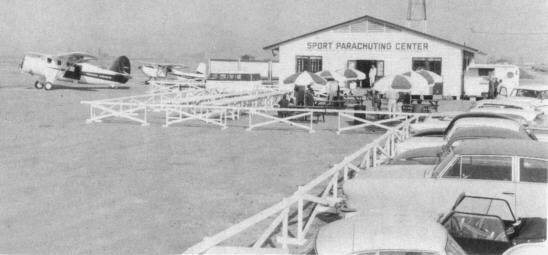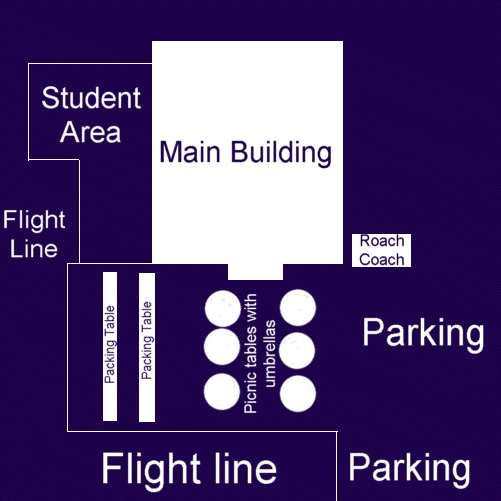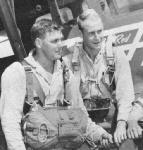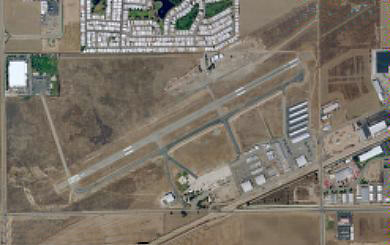Airport/Facility
ID : HMT
Facility
Key : 01654.*A
Facility
Name : HEMET-RYAN (Ryan Field)
Facility
Type : AIRPORT
County
: RIVERSIDE
City
: HEMET (03 miles SW)
State
: CA
Lattitude/Longitude
: 33.733980555556/-117.022525 (Estimated)
Elevation
: 1512 ft. (Surveyed)
Magnetic
Variation : 13E
Current
Owner : COUNTY OF RIVERSIDE
Current
Owner address : BOX 309, RIVERSIDE CA 92502
Current
Owner telephone : 909-275-6138
Current
Manager : JAKE GODOWN
Current
Manager address : 37552 WINCHESTER ROAD, MURRIETA, CA 92563
Current
Manager telephone : 909-696-2023
Sectional
: LOS ANGELES
Control
tower :
Lights
:DUSK-DAWN
Segmented
circle : Yes
Beacon
: CG
Landing
fee : None
UNICOM
: 123.000

Orange SPC was a spectacular success
that first year with TIME, LOOK and other magazines giving it considerable
space on the pages of their magazines. Orange, however suffered the
same problems as Lakewood did later on... the weather. PI made trips
to Florida and California in search of a winter home and chose Ryan Field
in Hemet, California to open their next center in late December 1959.
Massachutes or New Jersey weather would not have allowed a winter opening.
Lew Sanborn remarked in 1999 that they chose Hemet, California "not
only because of the weather, but due to more advanced attitudes about everything
in general". Establishing a foothold in California
was a good business move but PI didn't anticipate the more relaxed California
lifestyle. They saw the 11 million population of Southern California
instead. They would make their money primarily from training students.
Hemet is still a small town located
due east of Perris and about 90 minutes from San Diego and 2 hours from
downtown LA on State Route 74. Ryan Field is actually in the town
but at the time there was enough open space to build a huge landing area
south of the airport.
PI incorporated Hemet SPC separately
as the "Western Sport Parachuting Center" with Lew Sanborn as president
and George (The Hawk) Flinn as Secretary-Treasurer. Lew Sanborn was
the chief instructor and Dusty B. Smith became Assistant Instructor
(Dusty was your webmaster's first jump
course instructor and jumpmaster). Miss Kendall
Murphy was hired to do administrative and secretarial duties.
At this point we don't believe that
PI built any new buildings but took over existing space. There also
appears to have been a parachute club already at Hemet called Southern
California Sky Divers (headed by Dave Jesse of Santa Ana) and we don't
know if the buildings PI took over were used by or belonged to them or
not.
They had a central office/lounge,
parachute gear sales area, classrooms and a parachute loft without tower.
For food there was a small trailer roach coach. PI built 2 packing
tables to the right of the front door of the main building and fenced off
the jumpers' area in the same way they did at Orange and later Lakewood.
On the tourest side they put several tables with unbrellas for shade for
both jumpers and tourests and the tables soon became littered with gear..
We have not found (yet) any photos of the training areas.

Next came the landing area or LZ.
We believe the LZ was located south, across the road and railroad tracks,
from the main area, plus PI brought out the white with blue stripped VW
Van from Orange to bring people back from the LZ. The whole area
was ploughed regularly and it had the best and largest pea pit in California.
There were also distance markers ever 50 yards at the 4 points of the compus.
"Skydiver Magazine" made a point of doing a couple
 of
cover shots of it, the first in March 1960 with the shadow of the 180 camera
plane and two LoPo canopies just above the cross and a letter issue had
a shot looking down from under canopy with another jumper under a 28' Candy
Striped canopy below the cameraman. PI made sure that this issues
was always in the lounges at Orange and even Lakewood after Hemet closed
though too few of us realized that Jasques or PI had an interest in this
DZ when we read the magazines in the lounge at Lakewood. (Click
on photo to enlarge) of
cover shots of it, the first in March 1960 with the shadow of the 180 camera
plane and two LoPo canopies just above the cross and a letter issue had
a shot looking down from under canopy with another jumper under a 28' Candy
Striped canopy below the cameraman. PI made sure that this issues
was always in the lounges at Orange and even Lakewood after Hemet closed
though too few of us realized that Jasques or PI had an interest in this
DZ when we read the magazines in the lounge at Lakewood. (Click
on photo to enlarge)
PI placed the main Orange Norseman,
N13340 and the Cessna 180, N2484C "84 Charlie" at Ryan Field for the winter
and by summer 1960 was operating a leased Cessna 180 when 84 Charlie went
back to Orange. There is also evidence that Norseman "795 Red Lead"
also was moved to Hemet for the summer and 340 retyrned to Orange.
The two main pilots were Major "Bucky" Walters and Robert Venable with
Lew Sanborn in reserve. The leased aircraft was painted in the same
PI blue and white scheme as the Orange Cessna 182. There was also
a Twi-Beech that was used at the DZ for 15,000' jumps. The Beech
could be pre-arranged if you could get 9 experienced jumpers together for
high jumps. 795 Red Lead returned to Orange in March 62 along with
the staff and gear for the 62 World Meet and it never returned.
PI also moved many of their parachutes
and both vehicals (the station weagon and the VW Van) to Hemet which
all stayed there till the center closed. No doubt they were used
to drive the rigs and other gear to California and possibly some gear went
in the Norseman. Remember this was a time period when over half the
airliners in the USA were still prop jobs and the Cessna and Norseman trip
wasn't that much worse than a DC-7 and certainly more scenic. The
aircraft were flown via the northern route through Cheyanne, Wyoming to
avoid the Colorado Rockies. The movement of these 4 pieces of hardware
is a story in itself.
Hemet opened in December 1959 but
not officially. Bugs in the system needed to be ironed out and many
of the innovations developed at Hemet found their way back to Orange and
especially Lakewood when it was built. The new facility needed publicity
and some recognition to set it apart from near by Lake Elsinore DZ (Skylark
Aviation). Better facilities were a start, a great LZ (soon copied
by Elsinore) and a few records were the main draw card. Lew Sanborn
and Dusty Smith made the world's first Double Baton Pass on January 3rd,
1960 at Hemet.
 PI
also advertised heavily in local papers as well as national magazines.
The ad on the left (hover mouse to enlarge and read story) was in the June
1960 SKYDIVER Magazine. The location of of Hemet made it accessable
from both Los Angeles and San Diego with only Oceanside and the Elsinore
DZ's in competition. (Perris Valley had not opened yet) PI
also advertised heavily in local papers as well as national magazines.
The ad on the left (hover mouse to enlarge and read story) was in the June
1960 SKYDIVER Magazine. The location of of Hemet made it accessable
from both Los Angeles and San Diego with only Oceanside and the Elsinore
DZ's in competition. (Perris Valley had not opened yet)
Taking on Elsinore (Skylark Field)
was no small job. One of the earliest DZ's in America it was owned
(at the time) by Mr. and Mrs. Cy Perkins and Cy's brother Larry and since
it's opening in Feburary 1958 over 3000 jumps were made there. It
was a major sport aviation center at the time offering flying, pilot instruction
and gliders as well as parachuting. They had a Cessna 172 and 2 Howards
of their own plus others by arrangement. Cliff Winters, Larry Perkins,
Cy Perkins and Howard Curtis flew the Elsinore fleet. The facilities
were makeshift though and not purpose built like Hemet's. They did
however have a covered packing area (as did Perris later on when it opened)
which Hemet did not. Elsinore's prices were also about 50¢ to
75¢ cheaper per jump. Doesn't sound like much but when you consider
that a hamburger was someplace between 25¢ and 35¢ each (real
food not fast food) and gas was 19¢ a gallon it made a big difference
to someone jumping on a budget. In todays' money PI's first jump
course would have been about $180 to 200.
Also located at Elsinore Field was
Para-Ventures. This company had Dave Burt as president, Jim Hall
and the famous Bob Sinclair in the company. It trained students and
made jumps but what also the major supplier of jumpers for the movie industry
including the TV series THE MAN AND THE CHALLANGE, an all parachuting show
staring George Nader. Para-Ventures always had the biggest booth
in the aviation area at the Los Angeles Internat- ional Sports, Vacation
and Travel Show.
There was also competition to the
south for the San Diego market. The San Diego Skydivers, located
at Santee's Gillespie Field, was a major center which hosted many national
events including military and PCA (forerunner of the USPA) events.
The San Marcos Skydivers and the Desert Sky Divers didn't help either.
San Marcos, which was open every sunday and had their own hanger at McCormick
Field, was 80% US Marines and 20% civilians.
Hemet also had a lot of competition
in the gear sales area, more than they ever had before. We don't
believe that PI/WSPC marketed SECURITY Parachute Company products while
in California (Westerners tended to use Security Gear while Easterners
tended to buy Pioneer gear from PI). Elsinore had SKYLARK SALES (right
on the field) owned by Larry Perkins and Lyle Cameron (editor and publisher
of Skydiver Magazine) and just down the road was a mile and a half was
Jack Root's "SPORTSMAN Sales". The LA basin itself had several more
including:
| Ben's
Surplus |
Sepulveda
Blvd, Van Nuys |
| California
Parachutes |
15745
Lassen St, Sepulveda |
| D.L.M.
Parachute Company |
11817
S. Singleton Dr, Whittier |
| Glendale
Parachute Supply |
Glendale |
| Irvin
Airchute Company |
Irvine
(made all new gear) |
| Para-Ventures |
Hollywood |
| Russ
Wheeler |
747
W.115th Street, Los Angeles |
| Shorty
Stark's Loft |
1229
N.Sycamore, Hollywood |
| Transcontinential
Sales Co. Inc |
3072
W.Peco Blvd, Los Angeles |
| Volume
Sales |
Los
Angeles |
Once opened, the Center was run
by Lew Sanborn and was open 6 days a week (closed Tuesdays) to take advantage
of the California weather.
PI had established an excellent
record for safety and adopted procedures that some Californians considered
military regimentation. The lining up for pin checks while standing
on numbered boards was common to us in the east and no one thought anything
about it but in California that same lifestyle that opened minds to such
things as skydiving (remember this is 1959 we're talking about) also found
the safety regimentation annoying. Many jumpers after the FJC prefered
a looser DZ like Lake Elsinore down the road to the south West.
 PI
used newer Pioneer sport gear while most jumpers in the area had surplus
military gear and some Security Tracker rigs. PI managed to introduce
some Pioneer equipment into the area via it's sales and service arm but
it was rough going when the companies listed above plus Elsinor was selling
new or like new surplus (complete) USAF B-4 rigs (Harness, container, canopy,
risers, ripcords and pilot chute) for $30-40 and new 28' C-8 and C-9 canopies
for $15. Complete sporterized B-4 rigs with sleeve, D-Rings
and reserve ran anywhere from $60 to $100 while a new Pioneer LoPo in a
Pioneer main sport rig at almost $400. (Mouse over the photo above
to view the gear of the day in California) PI
used newer Pioneer sport gear while most jumpers in the area had surplus
military gear and some Security Tracker rigs. PI managed to introduce
some Pioneer equipment into the area via it's sales and service arm but
it was rough going when the companies listed above plus Elsinor was selling
new or like new surplus (complete) USAF B-4 rigs (Harness, container, canopy,
risers, ripcords and pilot chute) for $30-40 and new 28' C-8 and C-9 canopies
for $15. Complete sporterized B-4 rigs with sleeve, D-Rings
and reserve ran anywhere from $60 to $100 while a new Pioneer LoPo in a
Pioneer main sport rig at almost $400. (Mouse over the photo above
to view the gear of the day in California)
One of the ways PI attracted attention
to Orange was by running meets and conferences and Hemet followed heavily
into that. Hemet's Grand Opening was in fact a Meet!!
The official opening was on Sunday,
January 17th, 1960 and it was a huge affair, in fact too huge! Police
estimated that over 5000 people were at the opening which created safety
and traffic problems.
All five of the PI Partners were
there as well as a well briefed and pampered media. The morning started
out with a first jump class using the TELSAN Training Method. The
class included the owners of the Hemet Valley Flying Service, Mr. Lloyd
Venable, Bob and Jim Venable, their wives, and Harold Brister. The centers
own personal secretary, Miss Kendall Murphy, made her first jump with this
group.
When the official ceremonies got
under way, Jacques Istel introduced Mayor James Simpson of Hemet and Chairman
of the Riverside Airport Commission. Mayor Simpson then headed the
dedication ceremonies. Other distinguished guests on hand were Retired
General Joseph Marriot (also of the Riverside Airport Commission), various
representitives from California, Federal Election Districts, the Ensenada
Naval Air Station and oddly enough some top Mexican Officials of the Baja.
What interest the neighbors from South of the border had is unknown.
Next were some exhibition jumps
staged by Lew Sanborn, George Flinn, and Dusty Smith beginning with a 30
second smoke jump. Shortly after this, the first official load was
flown. The so-called Champaign Flight consisted of 9 jumpers,
representing 3 clubs and included: Lynn Pyland, Verne Williams, Walt Pica,
Bud Keisow, Don Byran, Bob Sinclare, Bob Highbee, Merle Ruby and Ed Cooley.
The group made a one-pass/all out 20 second from the Norseman. PI
made sure that there were several multi-colored Pioneer LoPo's or dyed
surplus canopies on the load whic seemed to have impressed the crowd even
more.
The
Champaign Load
Click
on the photos to enlarge
At approximately 2:00 o'clock, a
Meet got under way with 58 entrants. Each entrant received two jumps for
the price of one for entering the contest. As it turned out, there wasn't
enough daylight left for every one to get in their second jump. Consequently
the first jump ruled in the contest, and the winners were as follows :
| WOMAN'S
EVENT |
|
| Roxy McDonald,
(wife
of J. P. McDonald of the San Diego Sky Divers) |
Winner
of the Woman's Event |
| MEN'S
EVENT |
Advanced |
Ray Petrogallo
Elsinore
Valley Sport
Parachute
Club |
First
Place with 9 feet |
Verne Williams
Elsinore
Valley Sport
Parachute
Club |
Second
Place with 10 feet 4 inches |
John Fritas
San
Marcos Sky Divers |
Third Place with
11 feet 2 inches |
| MEN'S
BEGINNERS |
|
Dr. Wm H. Lockward
Sky-Hi
Pioneers of Phoenix, Arizona |
First
Place with 26 feet 2 inches |
Richard Curtis
San
Marcos Sky Divers, San Marcos, California |
Second
Place with 34 feet 8 inches |
Michael McCreery
San
Marcos Sky Divers, San Marcos, California |
Third
Place with 35 feet |
Those who still had a free jump
coming received jump tickets to be used
anytime they return to jump at
Hemet. Its interesting to note that the Winner of the Men's Beginners
Catagory, Dr. William Lockwood (who would go on to become a well known
name in the sport) won the competition with his 4th and 5th Static-Line
jumps!!!
Other
Opening Day Photos
Click on Photos
to enlarge
 Hemet
was to host other Meets, the first on July 3rd and 4th 1960. (Hover
mouse on photo left for full story)
Of all the meets, the favorite by far was the "Hit and Run" Meets. In this
competition you were scored first on the distance from the target you landed
and the instant you landed you were timed as to how long it took you to
reach and tag the disk. Hemet went one step farther and installed a buzzer
switch at the disk. Hemet held another big "Hit & Run" on December
18, 1960 and it attracted many of the big names of the day. One sneaky
way of getting excellent scores was to land on the disk and hope you can
find it under you someplace or land next to it and tag it as you landed.
It was preferable to land upwind if you couldn't get the disk rather than
landing downwind and having to tow your inflated canopy to the target. Hemet
was to host other Meets, the first on July 3rd and 4th 1960. (Hover
mouse on photo left for full story)
Of all the meets, the favorite by far was the "Hit and Run" Meets. In this
competition you were scored first on the distance from the target you landed
and the instant you landed you were timed as to how long it took you to
reach and tag the disk. Hemet went one step farther and installed a buzzer
switch at the disk. Hemet held another big "Hit & Run" on December
18, 1960 and it attracted many of the big names of the day. One sneaky
way of getting excellent scores was to land on the disk and hope you can
find it under you someplace or land next to it and tag it as you landed.
It was preferable to land upwind if you couldn't get the disk rather than
landing downwind and having to tow your inflated canopy to the target.
 Many
records were set at Hemet too. The most publicized was the first
3-way baton pass involving a woman. This was set by Lew Sanborn,
Sherri Buck and Bob McDonnell. There was a lot of competition between Elsinor
and Hemet in the record department. (Hover
the mouse over the photo to enlarge it and read the full story). Many
records were set at Hemet too. The most publicized was the first
3-way baton pass involving a woman. This was set by Lew Sanborn,
Sherri Buck and Bob McDonnell. There was a lot of competition between Elsinor
and Hemet in the record department. (Hover
the mouse over the photo to enlarge it and read the full story).
 While
managing Hemet SPC, Lew Sanborn also made his 500th jump from the Center's
Cessna 180. (Hover the mouse
over the photo to enlarge it and read the full story) While
managing Hemet SPC, Lew Sanborn also made his 500th jump from the Center's
Cessna 180. (Hover the mouse
over the photo to enlarge it and read the full story)
Hemet
also trained it's share of "Boy Skydivers" and three ( Roger Akers, Ralph
Barnes and Richard Gore) made the papers by jumping into their graduation
ceremony at Mahar Regional High School in June 1960. Hemet was happy
to help with the feat after Elsinore trained a group of Montclair High
School "lettermen" (football) including Senior Class President Jay Ward.
The group formed the first high school team/club in America. Members
included Jay Ward, John Serra, Dick Tallette, Bill Beezsley and Part Ward.
After
a successful start the center moved the picnic tables over a bit and installed
3 more packing tables. Packing was done in a civilized manner then,
on tables not crawling around on the ground. More personel were added,
most notable was Denny Manning, son of the famous barnstorming jumper Spud
Manning. Denny's son, xxx, also joined the team as a desert
rat and shagger.
The Center was closed in March 1961
after 27 months of operation to concentrate all the corporate resources
on the 1962 World meet. The Hemet based Norseman (795 "Red Lead")
and the staff returned to Orange with all the gear and vehicals and the
center was not reopened. By the time it closed, Hemet was well known
around the country. It's closure allowed Lake Elsinor to grow and
Perris Valley DZ to open.
Hemet
Photo Gallery
 |
 |
 |
 |
|
Maps
|
Main Area
|
Drop Zone
|
Aircraft
|
Click on images above for more details and
photos.
HEMET TODAY
.

The original PI building
is theone by the road in the lower left. We believe the Landing Zone
was south of the airfield in the field acrosss the street.
Hemet airport has grown into a very
decent facility (photo above) with over a dozen hangers of various types.
We believe that the original PI building is the white structure at the
lower left hand corder of the property. The railroad still runs parallel
to the runway on the other side of the hangers.
We are not sure where the landing
area was, it could be across the road from the airport (south), where the
trailer park is now or the rough area by the runway. Aerial photos
show absolutely no evidence of the huge ringed circle that was once the
DZ.
After PI/WSPC left Hemet, the DZ
occassionally operated as a small club on and off over the years and is
currently opened again operating a Twin Otter. The current DZ operations
at Hemet are at http://??
Anyone having any more information
about the history of this DZ or the people, is invited to, if not BEGGED
to contribute.
I recently dug up an old negative
(below) that I shot in Air Force Photo School. We were told to take
the contents of our wallets and make a still life style photo on a plain
back ground. I had jump photos and two PI tickets from Lakewood still
on me.
|

